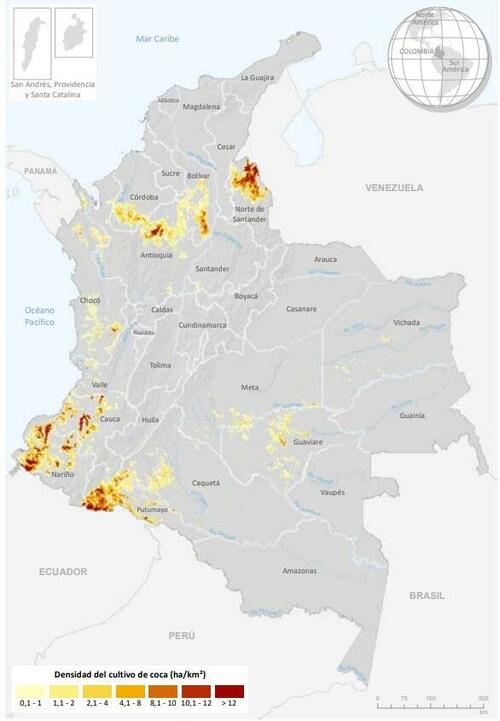Record Cocaine Production Impacts Colombia’s Oil Industry!
Authored by Matthew Smith via OilPrice.com,
-
UNODC reports Colombia’s cocaine production hit a record in 2022, nearing the country’s oil export earnings.
-
Major oil-producing regions, like Putumayo, overlap with high-density coca cultivation zones, fueling conflicts and disrupting oil operations.
-
Rampant oil theft from key pipelines, driven by the cocaine trade’s demand for gasoline, harms the environment and impacts Colombia’s petroleum production.
Colombia’s cocaine production continues to soar ever higher. For the fourth year straight, the United Nations Office on Drugs And Crime (UNODC) reported that Colombia’s 2022 cocaine output surged to yet another all-time high. Since the early 1980s, the tremendous profits generated by the narcotic have been responsible for fueling the strife-torn county’s civil conflict and heightened rural violence. Crime and violence are spiraling out of control in Colombia despite the country’s first leftist president Gustavo Petro, himself a former Marxist guerilla, committing to a policy of total peace. Rising crime, violence and conflict will roil an economy already struggling to grow, with Colombia’s oil industry being hit hard by cocaine-fueled conflict with many petroleum-rich regions located in or near coca-cultivating hotspots.
In a stunning development, the UNODC reported that Colombia’s 2022 coca harvest (Spanish) grew 24% year over year to 1.4 million metric tons, which had the potential to produce 1,738 metric tons of cocaine hydrochloride, also a 24% increase from a year earlier. This immense surge in cocaine production has sparked fears that the narcotic will generate far greater export earnings than Colombia’s primary export, crude oil, earning $18.7 billion for 2022 and $10 billion for the first eight months of 2023. According to Bloomberg, Colombia’s 2022 cocaine exports were worth $18.2 billion, or 5% of gross domestic product, which is slightly less than the $18.7 billion earned by oil.
The tremendous and growing volume of cocaine being manufactured in Colombia, despite giving the economy a notable short-term boost, poses a threat to the Andean country’s legitimate industries, notably the hydrocarbon sector. Many of Colombia’s top-producing oil basins are located in areas that are known hotspots for coca cultivation and cocaine production. The top four zones, where coca cultivation and cocaine manufacturing dominate the local economies, are shown on the map below, with the highest density shown in red.
Source: UNODC Monitoreo de los territorios con presencia de cultivos de coca 2022 septiembre 2023.
As the map illustrates, the densest coca-growing areas are in Putumayo near the border with Ecuador, the Pacific Coast of Nariño around the port of Tumaco, Northern Antioquia, and the Catatumbo Region in the department of Northern Santander. Putumayo, where the oil-rich Putumayo Basin is located, experienced a stunning 68% increase in the volume of acreage under coca cultivation in 2022. As a result, the department becomes the second largest coca-growing area in Colombia behind the Pacific region, which includes the coastal departments of Nariño, Valle de Cauca and Choco.
Putumayo, which was long a stronghold of the Revolutionary Armed Forces of Colombia (FARC – Spanish initials), which demobilized in a controversial 2016 peace deal, is a flashpoint for a bloody and escalating conflict between illegal armed groups. Most of that fighting is between two FARC dissident groups, those elements of the leftist guerillas who did not accept the 2016 peace agreement, the Carolina Ramirez Front and Border Command. That conflict is centered around controlling valuable coca cultivating areas and smuggling routes into neighboring Ecuador, which emerged over the last five years as a key international transshipment point for cocaine.
The ongoing strife in Putumayo continues to impact the department’s oil industry and creates fallout for industry operations in the nearby departments. It was in neighboring Caquetá, also a one-time FARC stronghold, where earlier this year, community protests spilled over into violence, forcing Sinochem subsidiary Emerald Energy to shutter operations at the Capella oilfield. Colombia’s national police believe the protest and ensuing violence (Spanish) was fomented by FARC dissidents operating in Caquetá led by Iván Mordisco, commander of the group known as the FARC-EMC. Elements of that dissident group are heavily involved in coca growing and the manufacture of cocaine in Putumayo, Caquetá and Arauca.
Community blockades of oil industry operations in Putumayo which disrupt production, are also frequent events. Putumayo is an important oil-producing area. The province, with proven reserves of 39 million barrels, ranks ninth among Colombia’s departments by oil reserves and is sixth on the basis of accumulated production, which during 2022 hit 8.9 million barrels. Blockades by farmers, many of whom cultivate coca, while not directed at the oil industry, cause production outages and prevent supplies as well as petroleum from being shipped by road. Putumayo has suffered considerable civil unrest, with the department being targeted for intensive coca eradication efforts by the central government in Bogota. There is also growing dissent against the oil industry because of environmental damage and the failure of companies to adequately consult with local communities.
A combination of higher fuel prices after oil rallied, with Brent rallying by 13% over the last three months, and soaring demand for gasoline to process coca leaves makes petroleum theft a highly lucrative activity in Colombia. Tremendous volumes of gasoline, a critical chemical in the process of manufacturing cocaine, are used to extract the crucial alkaloid that is eventually processed into cocaine hydrochloride. It is estimated that 75 gallons of gasoline is required to process enough coca leaves to produce one kilogram of cocaine. This means over 130 million gallons of gasoline was required to produce the 1,738 metric tons of cocaine the UNODC estimates was manufactured in Colombia during 2022. Surging cocaine production makes oil theft from Colombia’s pipelines, with the Caño Limon and ODL pipelines the most popular targets, an increasingly lucrative activity.
The 233,000 barrel per day Bicentenario oil pipeline (ODL – Spanish initials), which connects the Putumayo Basin to the Pacific Coast port of Tumaco, passes through key coca-growing hotspots in Putumayo and Nariño. The pipeline is the target of frequent attacks, not only to prevent its operation but also to steal petroleum. The oil, after being stolen from the ODL pipeline, is processed into a rudimentary form of gasoline in primitive jungle refineries near the Pacific coast port of Tumaco. The crude fuel, known as pategrillo or cricket foot because of its greenish hue, is then used to process coca leaves.
In 2022, 141 illegal valves were found applied to the ODL pipeline (Spanish) to facilitate the theft of oil. Those are responsible for causing frequent pipeline outages and, along with the nearby primitive jungle refineries, are the source of many environmentally damaging oil spills. The shuttering of the vital ODL pipeline, which is the only economic means of transporting oil from the Putumayo Basin to the Pacific port of Tumaco, sharply impacts Colombia’s petroleum production. Drillers operating in the Putumayo Basin are forced to use higher capacity road transportation for the oil they are producing or store it on site until those facilities reach full capacity and then shutter wells.
The rapid expansion of cocaine production in Colombia, while giving the Andean country’s GDP, current account and direct investment a boost, is severely impacting the legitimate economy. The manufacture of the narcotic, at all stages of the value chain, is heavily afflicted by conflict, crime and violence. Coca cultivation, as well as the production of cocaine hydrochloride, are all controlled by an array of illegal armed groups who use violence to control territory because of the vast profits those activities generate. It is Colombia’s economically crucial oil industry, which is the largest legitimate export and responsible for 3% of GDP, that is being sharply impacted by soaring cocaine production and associated violence.
Tyler Durden
Fri, 10/13/2023 – 08:20
via ZeroHedge News https://ift.tt/HZlzaOt Tyler Durden

